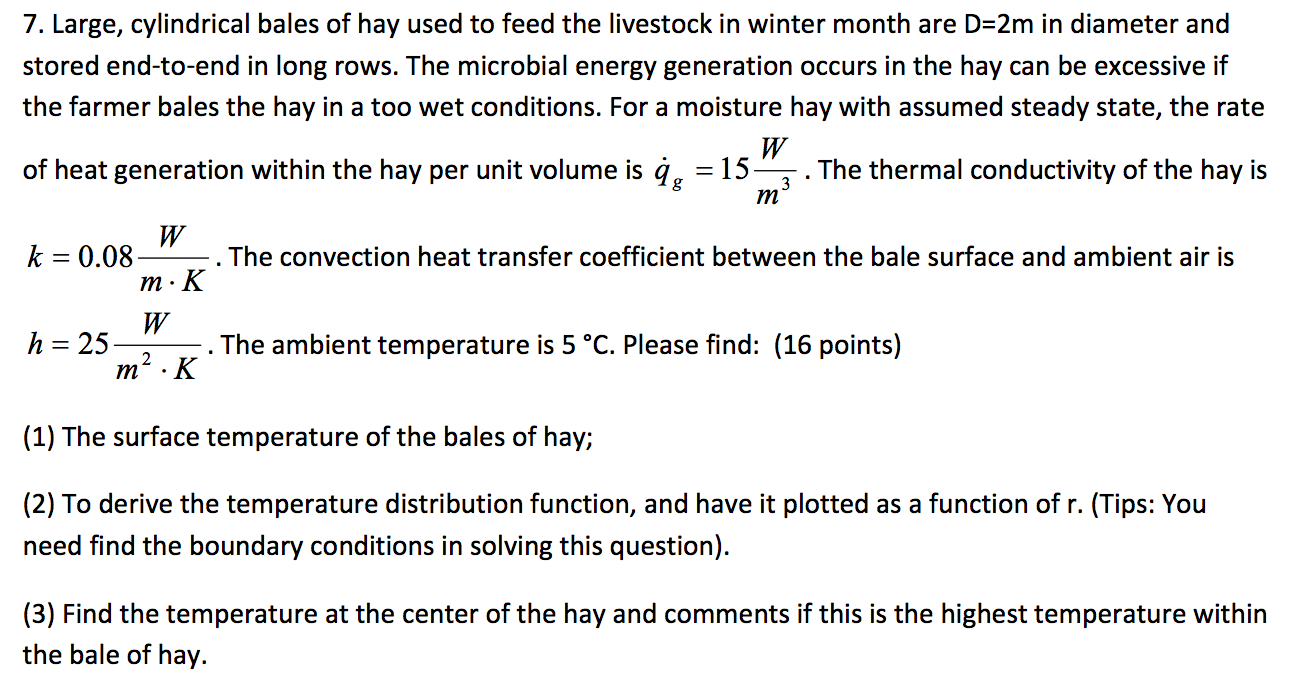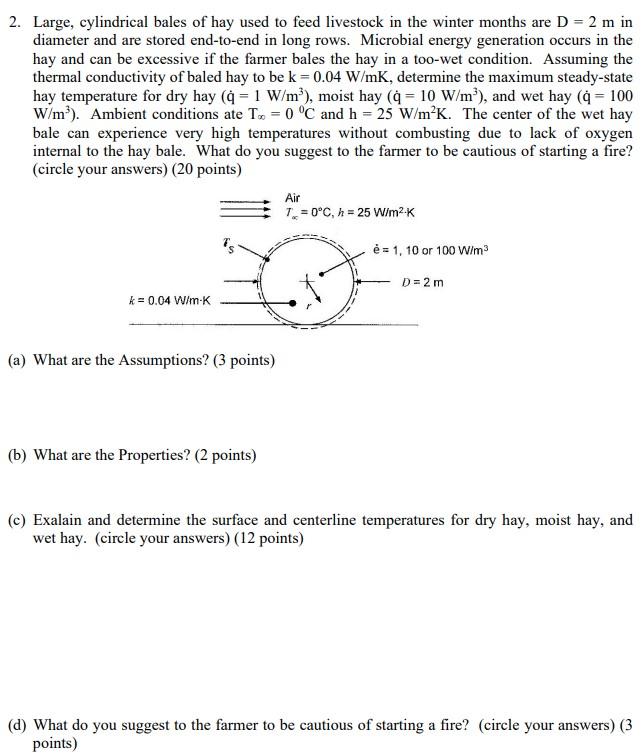Large Cylindrical Bales of Hay Used to Feed
Is a big round bale really better or easier to work with than a. Large cylindrical bales of hay used to feed livestock in the winter months are D2 m in diameter and are stored end-to-end in long rows.

Solved 7 Large Cylindrical Bales Of Hay Used To Feed The Chegg Com
The bales are wrapped in plastic usually foil plastic which is applied in 6-8 layers so that the plastic gasket is airtight.

. Large round cylindrical straw or hay bales in countryside on yellow wheat field in summer or autumn after harvesting on sunny day. K 004 W m K. Determine the maximum temperature in the wall.
Microbial energy generation occurs in the hay and can be excessive if the farmer bales the hay in a too-wet condition. How tall are the plants. Feeding is hay-based both in the cold season and together with grazing in the warm season.
Large cylindrical bales of hay used to feed livestock in the winter months are D 2m in diameter and are stored end-to-end in long rows. Assuming the thermal conductivity of baled hay to be. Large cylindrical bales of hay used to feed livestock in the winter have a diameter of D 2m and are stored end-to-end in long rows.
Hay is packed in large cylindrical bales round bales nearly 241 m3 or rarely in traditional small prisms-shaped bales about 015 m3 only used on small farms. Assuming the thermal conductivity of baled hay to be 004 Wm K determine the maximum. How much is each bale going to weigh the more weight.
Microbial energy generation occurs in the hay and can be excessive if the farmer bales the hay in a too-wet condition. Round hay bales are grass pressed hard together in a cylindrical bale using a round baler. Large cylindrical bales of hay used to feed livestock in the winter months are D2 m in diameter and are stored end-to-end in long rows.
Large cylindrical bales of hay used to feed livestock in the winter months are D 2 m in diameter and are stored end-to-end in long rows. Large cylindrical bales of hay used to feed livestock in the winter months are D2m in diameter and are stored end-to-end in long rows. The convection heat transfer coefficient between the wall and the fluid is 500 Wm 2 K.
The bales of this type are several feet in diameter and consequently present difficult handling problems in transporting the bales to a feeding sight. In this video Ill show you how I feed 3 x 4 x 8 big bales of grass hay to my cattle without the use of a tractor. Large cylindrical bales of hay used to feed livestock in the winter months are D 2 m in diameter and are stored end-to-end in long rows.
382 Large cylindrical bales of hay used to feed livestock in the winter months are D 2 m in diameter and are stored end-to-end in long rows. Assuming the thermal conductivity of baled hay to be k004WmK determine the maximum steady-state hay temperature for dry hay qdot 1Wm3 moist hay qdot 10Wm3 and wet hay qdot. The answer depends on a lot of variables.
The feeder device is utilized particularly in the feeding of large cylindrical shaped bales of hay one of which is indicated at 31 in FIG. Large cylindrical bales of hay used to feed livestock in the winter months are D 2 m in diameter and are stored end-to-end in long rows. Large cylindrical bales of hay used to feed livestock in Microbial energy generation occurs in the hay and can be excessive if the farmer bales the hay in a too-wet condition.
Microbial energy generation occurs in the hay and can be. These hay bales found on modern farms are extremely large and heavy weighing upwards of 1500 pounds each. Microbial energy generation occurs in the hay and can be excessive if the farmer bales the hay in a too-wet condition.
This requires a large production of hay and frequent handling by the farmers. EnjoyPlease like and Subscribe to sho. Todays large round bales of hay range from 12 to 18 meters wide and can weigh up to 1000 kg about 2200 pounds.
Assuming the thermal conductivity of baled hay to be k 004 WmK determine the maximum. Microbial energy generation occurs in the hay and can be excessive if the farmer bales the hay in a too-wet condition. Microbial energy generation occurs in the hay and can be excessive if the farmer bales the hay in a too-wet condition.
The more material it will take to make a bale. When the bales are placed upon the ground for feeding as much as one-half of the bale is wasted. Assuming the thermal conductivity of baled hay to be.
Microbial energy generation occurs in the hay and can be excessive if the farmer bales the hay in a too-wet condition. A bale 31 is generally about 6 feet in diameter with a length of 5 feet or more and weighing from a 1000 pounds to 1500 pounds depending upon the bale density namely the compactness of the bale. Is this the first cutting.
Microbial energy generation occurs in the hay and can be excessive if the farmer bales the hay in a too-wet condition. How thick are the plants. Usually both bale width length of the cylinder and diameter are about 125 meters.
Large cylindrical bales of hay used to feed livestock in the winter months are D2m in diameter and are stored end-to-end in long rows. Microbial energy generation occurs in the hay and can be excessive if the farmer bales the hay in a too-wet condition. A cow will eat 3 per cent of her body weight a day so a 1200 pound cow needs 36 pounds of hay per day-she also need protein so if your hay is poor quality you will need to feed a supplement with it but high quality hay having over 15 per cent protein will suffice-around here we figure on feeding hay 100 days a year so a single cow will need 50 small square bales or 2 to 3 large.
Solved Large Cylindrical Bales Of Hay Used To Feed Livestock In The Winter Months Are D 2 M In Diameter And Are Stored End To End In Long Rows Course Hero

Solved 3 69 Large Cylindrical Bales Of Hay Used To Feed Chegg Com

Solved 2 Large Cylindrical Bales Of Hay Used To Feed Chegg Com
Comments
Post a Comment